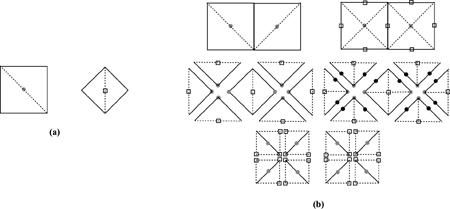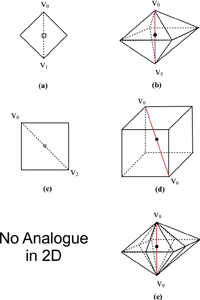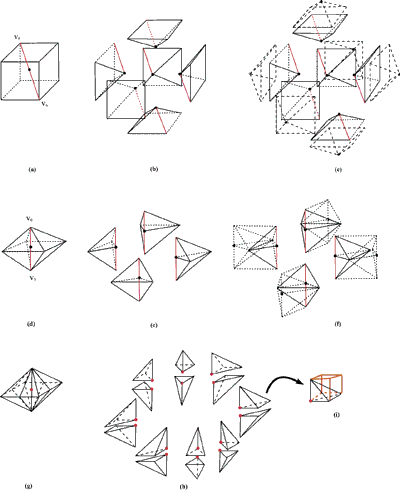 This issue in pdf Archive: |
|
|||||||
Dealing with Massives Volumetric Visualisation:
|
 |
| Figure 1: a) 2D First and second level diamonds; b) 2D subdivision. |
 |
| Figure 2: 2D diamonds vs. 3D diamonds. |
In 3D, the bisection edge refinement becomes a schema for the subdivision of tetrahedral meshes. It applies to tetrahedral meshes in the same way that it applies to 2D triangular meshes. With respect to the 2D case it maintains all the properties. Each cell is still subdivided along 'the longest edge', which corresponds to the main diagonal of the cell itself. Each bisection gives birth to an arbitrary number of diamond-like new cells. For regular grids, the starting cell is a first class cube-shaped diamond cell (see Figure 3a). The bisection of a first class diamond cell gives birth to second class octahedral-shaped diamond cells (Figure 3b-c). Each new second class diamond cell (Figure 3d) is bisected along its main diagonal and third class esahedral-shaped diamond cells are created (see Figure 3e-f). Each esahedral cell (Figure 3g) is bisected along its longest diagonal and generates first class diamond cells (Figure 3h-i). In 3D, we need to repeat the bisection procedure three times to reach a stage in which a new bisection gives birth to first class cube-shaped cells, returning to the subdivision step for the starting cell (see the third level diamond in Figure 2e) .
Hierarchical Organisation: The subdivision schema implies a hierarchical organisation of the dataset. It is easy to organise such a hierarchy in a tree-like data structure and to extract a sort of 'seed set', made up of cells whose internal range of isovalues includes the isovalue target. The seed set generated corresponds to an adaptive traversal of the mesh at different levels. The hierarchy always starts with a first class diamond cell and proceeds through each level of refinement with an alternation of second, third (for the 3D case) and first class diamond cells.
 |
| Figure 3: First, second and third level diamonds and respective subdivision and fusion with adjacent cells. |
Isosurface Extraction: Each generated diamond internally holds a 'piece' of the total isocontour that needs to be extracted. To perform the extraction, for the 3D case, we subdivide each diamond cell into tetrahedra and apply a marching tetrahedra algorithm. Each isocontour is updated within a single tetrahedron and then composed to update the global isosurface within the set T of all tetrahedra around the bisection edge.
The key novelty of the present schema is that, by providing a set of local rules for continuous geometric transitions (geomorphs) of one level of resolution into the next, we bridge the gap between adaptive techniques and multi-resolution decimation-based techniques. Moreover, the regularity of the schema permits the design of an efficient run-time data partitioning and distribution algorithm which will reduce local memory requirements and will make use of the potential of the currently under-exploited distributed environment.
Please contact:
Rita Borgo
Pisa University and ISTI-CNR
Tel: +39 050 315 3471
E-mail: borgo@di.unipi.it
Roberto Scopigno, ISTI-CNR
E-mail: r.scopigno@cnuce.cnr.it
Valerio Pascucci
Lawrence Livermore
National Lab, USA
E-mail: pascucci@llnl.gov

